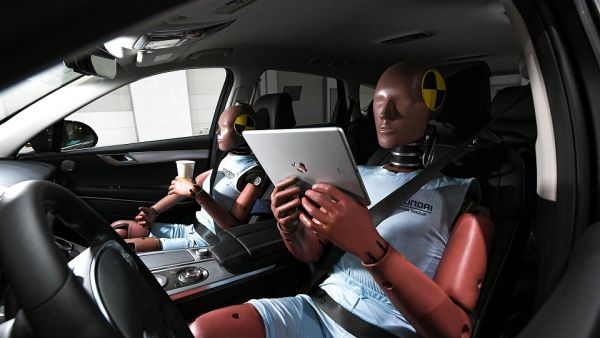Hyundai Developing Advanced Safety System Controls to Protect Passengers in Autonomous Vehicles

Hyundai Motor Company has started to develop advanced occupant safety technologies to help reduce the risk of passenger injuries in autonomous vehicles. The companies revealed the first stage of this development today: a control algorithm optimized for autonomous driving conditions.
Autonomous vehicles use advanced technologies such as on-board cameras and radar sensors to determine risk factors and greatly reduce the likelihood of accidents. However, researchers have determined the need for specialized safety system controls that are optimized for autonomous driving conditions, given the risk of other vehicles crossing the centerline or the sudden appearance of other hazards or obstacles.
To this end, Hyundai has developed a new autonomous vehicle safety control algorithm, aimed at reducing the risk of such accidents and mitigating their impact. As an autonomous vehicle reduces its speed or changes direction to avoid a sudden hazard or obstacle, the control algorithm calculates occupants’ anticipated movements. These calculations enable the system to optimize use of on-board safety devices, such as airbags and seat belt pretensioners.
Hyundai has tested a range of autonomous driving scenarios and found that, in steering to avoid the obstacle, the car threw a passenger off balance before colliding with the obstacle. Under these circumstances the passenger was out of position as the airbag deployed, providing reduced protection.
By applying the new algorithm, however, the airbag and seat belt pretensioner were deployed more effectively to provide far greater protection to the passenger. The algorithm reduced the passenger’s angle of movement by momentarily tightening the seatbelt pretensioner just before the collision. This stabilized the passenger’s posture and provided further protection by pre-activating the side and curtain airbags at the moment of the crash.
Even in a scenario where the autonomous car brakes to a halt and successfully avoids an obstacle, the algorithm still pre-tightens the seat belts to reduce the risk of injury while the possibility of a collision still exists.
The new algorithm will be applied to a range of future autonomous vehicles from Hyundai.
“Aligned with autonomous driving vehicle developments, Hyundai is proactively developing new safety technologies to maximize passenger safety,” said Wook Jin, Head of Integrated Safety Development Group at Hyundai Research & Development Division. “We are directing our efforts toward creating the safest autonomous driving technologies that provide maximum protection to passengers, even if the vehicle they are travelling in takes action to avoid a collision. These safety technologies will help prepare our vehicles and their users for a future of shared autonomous mobility and purpose-built vehicles.”
Background Information
Hyundai Motor
Hyundai Motor Company recognizes the importance and impact that automobiles have on society and mankind. It strives to play a role that extends beyond being a simple car manufacturer to become customers’ lifetime companion. It will build connections with customers by fulfilling its vision to become a “lifetime partner in automobiles and beyond” and participate in working “together for a better future” as a constituent of Hyundai Motor Group.






